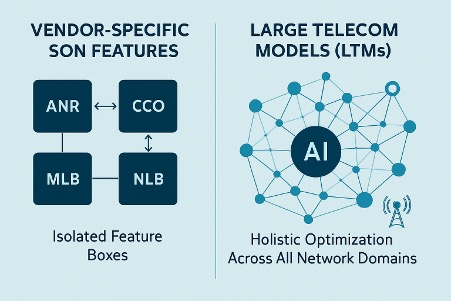The Evolution of Self-Organizing Networks: From SON to Cognitive SON to LTMs
As we approach 2030, the telecommunications industry is at a point where traditional network automation methods are merging with advanced AI technologies. Based on my experience over the past decade with network optimization solutions, I would like to share some insights on potential future developments.
As we approach 2030, the telecommunications industry is at a point where traditional network automation methods are merging with advanced AI technologies. Based on my experience over the past decade with network optimization solutions, I would like to share some insights on potential future developments.
Two Perspectives on SON Evolution
When discussing the future of Self-Organizing Networks (SON), it’s crucial to distinguish between two perspectives:
SON as a Conceptual Framework
The fundamental principles of self-configuration, self-optimization, and self-healing will remain essential to network operations. These core concepts represent the industry’s north star – autonomous networks that can deploy, optimize, and repair themselves with minimal human intervention.
These principles aren’t going away. Rather, they’re being enhanced and reimagined through more sophisticated AI approaches.
Vendor-Specific SON Implementations
The feature-based SON solutions we’ve grown familiar with – ANR (Automatic Neighbour Relations), CCO (Coverage & Capacity Optimization), MLB (Mobility Load Balancing), and others – are likely to undergo significant transformation or potential replacement.
These siloed, rule-based features operate with limited contextual awareness and struggle to optimize for multiple objectives simultaneously. They represent the first generation of network automation that’s ripe for disruption.
Enter Large Telecom Models (LTMs)
The emergence of Large Telecom Models (LTMs) – specialized AI models trained specifically on telecom network data – represents a paradigm shift in how we approach network intelligence.
Like how Large Language Models revolutionized natural language processing, LTMs are poised to transform network operations by:
- Providing holistic, cross-domain optimization instead of siloed feature-specific approaches
- Enabling truly autonomous decision-making based on comprehensive network understanding
- Adapting dynamically to changing conditions without explicit programming
- Learning continuously from network performance data
The Path Forward: Integration, or Replacement?
The relationship between traditional SON, Cognitive SON, and emerging LTMs is best seen as evolutionary rather than revolutionary.
- Near-term (1-2 years): LTMs will complement existing SON features, enhance their capabilities while learn from operational patterns
- Mid-term (3-4 years): We’ll see the emergence of agentic AI systems that can orchestrate multiple network functions autonomously
- Long-term (5+ years): Many vendor-specific SON implementations will likely be replaced by more sophisticated LTM-driven systems
The most successful operators will be those who embrace this transition strategically – leveraging the proven reliability of existing SON for critical functions while gradually adopting LTM capabilities for more complex, multi-domain challenges.

Real-World Progress
We’re already seeing this evolution in action. SoftBank recently developed a foundational LTM that automatically reconfigures networks during mass events.
These early implementations hint at the tremendous potential ahead as we move toward truly intelligent, autonomous networks.
Prepared By: Abdelrahman Fady | CTO | Digis Squared
